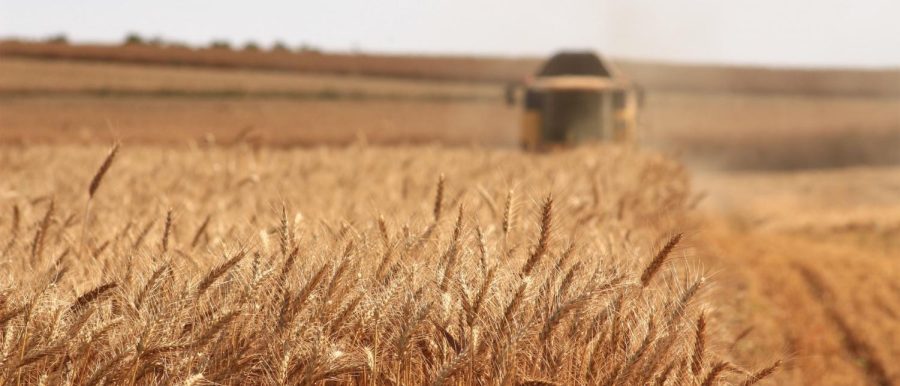The War in Ukraine begins to Affect Food Supply in Other Countries
Wheat and grain are major crops in the global market primarily produced in Ukraine and Russia. With blockades in Ukraine, it has become increasingly difficult for many countries to get these crops for their food supply. Image via. Wikimedia Commons
May 20, 2022
“America is fighting on two fronts,” President Joe Biden said during a speech in Kankakee, Illinois. “At home, it’s inflation and rising prices. Abroad, it’s helping Ukranians defend our democracy, and feeding those who are left hungry around the world because Russian atrocities exist. … And the American farmers understand Putin’s war has cut off critical sources of food.”
Biden blamed Russia’s invasion of Ukraine for domestic price hikes and global food supply shortage and voiced that the US needs to continue to invest in American farmers as they are the “backbone” of the economy and play a key role as the “breadbasket of democracy” during the war.
Biden has also announced actions aiming to stabilize domestic food production and lower US food costs, to conquer the goal of increasing the US food supply available for export to parts of the world that are currently dealing with food shortages due to the war.
The administration is specifically working towards efforts to double funding for domestic fertilizer production, expand insurance eligibility for “double cropping,” and provide additional technical assistance for precision agriculture and other technology/tools to reduce reliance on fertilizer.
Double cropping is the practice of harvesting two crops in the same field in the same year. The practice can have many risks but is one that “we need to take” according to the President.
Fertilizer is another supply found in a global shortage. This issue plays a big role in the increasing food prices and lowered crop sizes.
With Russia being the world’s biggest fertilizer exporter, prices for the ingredients of fertilizer have almost tripled since the start of the pandemic. This is the result of many factors such as the Russian invasion of Ukraine, supply chain issues caused by storms, and high natural gas prices.
Bloomberg explains, “For the first time ever, farmers the world over — all at the same time — are testing the limits of how little chemical fertilizer they can apply without devastating their yields come harvest time. Early predictions are bleak.”
Biden’s latest plans to help Ukraine include putting a half-billion dollars in increased farm subsidies. The President’s goal is to encourage US wheat, corn, and soybean production to make up for production lost from Ukraine.
Politico breaks down the proposal explaining what it would mean, “Under the Biden administration’s proposal, $100 million would go toward providing a $10-per-acre payment to farmers who plant a soybean crop after a winter wheat crop in 2023. Another $400 million would fund a two-year increase in loan rates for U.S. producers to encourage them to grow more select food commodities, including wheat, rice, and oilseeds like soybeans, sunflowers, and canola.
The Agriculture Department claims the proposal would help stabilize rising U.S. food prices and provide food for foreign countries in need, by helping American farmers grow 50 percent of the wheat normally exported by Ukraine, among other things. That plan, however, would probably also require the U.S. to step up funding for federal aid programs that buy and ship U.S. commodities abroad. Otherwise, wealthier countries like China would likely buy up the extra supply on the open market.”
The Federal Reserve Board will begin meeting to discuss possible solutions, with their goal being to have inflation running no higher than 2% a year.
As a result of the war in Ukraine, the prices of key agricultural products, especially wheat, which is primarily produced in the region have skyrocketed.
Russia’s invasion has caused a shock to commodity markets, something that will keep global prices high through the end of 2024, according to a report from the World Bank.
According to the report, food prices will increase by 22.9% this year, emphasized by a 40% rise in wheat prices.
In his remarks, Biden assured that his administration would be able to “make sure that American agriculture exports will make up for the gap in Ukrainian supplies.”
Ukraine is the primary provider of several major crops to world markets such as corn, wheat, maize, and barley.
The war and blockades of Ukrainian ports have stalled the global supply chains for these major crops. If this remains the case a food crisis is likely to occur.
Many ports currently hold many products ready for other countries that are unable to be exported because of the blockades in the country.
“If you have any heart at all for the rest of the world, regardless of how you feel about Ukraine, you need to open up those ports,” David Beasley told CNN directing his statement at Russian President Vladimir Putin, insisting that the blockades be lifted.
The blockades placed on Ukraine pose a risk for every country relying on its exports.
The US recently unveiled a multibillion-dollar plan which would work to address the worldwide food security crisis.
The US Department of the Treasury also announced that several global banks are “‘working swiftly to bring to bear their financing, policy engagement, technical assistance’ to prevent starvation prompted by the war, rising food costs and climate damage to crops.”
Despite the skyrocket in food prices in the US, many experts don’t expect that there will be horrible food shortages in the country.
“It’s important to realize that the U.S. doesn’t import very much from Ukraine,” explained Joseph Glauber, a senior research fellow at the International Food Policy Research Institute.
“We may see some shelves that are empty for various kinds of food products like we have for a while now as we recover from the pandemic,” said Scott Irwin, chair of agricultural marketing at the University of Illinois Urbana-Champaign. “But I can say with some real confidence that in the United States, the average consumer is not going to see a shortage of bread because of what’s going on in Ukraine.”







